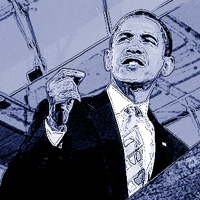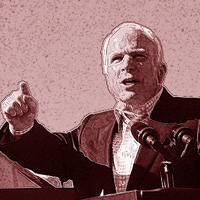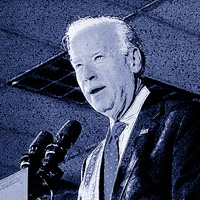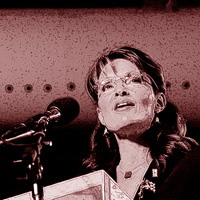In the general election, a number of orientating landmarks mark the way to Election Day: the traditional Labor Day kick-off, the ad campaign, September debate negotiations, the debates themselves, and a grueling last ditch effort as the candidates go all out to win over a few more voters in key states. Charges and countercharges fly; excitement builds. While all this is happening, the campaigns are operating with one goal in mind: 270. Two hundred-and-seventy electoral votes is the number needed to win, and major party presidential campaigns deploy their resources accordingly.
On June 19, 2008, betting on its strong fundraising capability, the Obama campaign announced it would forego the $84 million general election grant under the public financing system. This was something that had never been done under the 30-plus years of the system. Obama had earlier said he would adhere to the system and he came under criticism, but the move paid off in spades as his campaign enjoyed continued fundraising success, raised $233.2 million from Sept. 1 to Nov. 24. The Obama campaign's financial advantage meant more staff, more ads, and more glossy brochures, posters and other such items in key states. The analogy of a fully outfitted yacht competing against a canoe may be somewhat of an exaggeration but does give a sense of the race.
The Obama campaign could
have poured all that money into paid media, and indeed it did run an
extensive media campaign, but the real star of the campaign was its
ground game. The campaign used the
intensive field organizing it employed to such effect in the
primaries. In a June 9, 2008 e-mail, Obama for America
deputy campaign manager Steve Hildebrand wrote, "...I am proud to
announce that our presidential campaign will be the first
in a generation to deploy and maintain staff in every
single state." By Oct. 24, 2008 Mark Silva
of the Chicago Tribune
reported that the
Obama campaign had 770 field offices around the country. These
Campaign for Change offices focused on voter registration, a task which
the Democrats had outsourced to a considerable degree in the 2004
campaign. In
a conference call on Oct. 24, Obama campaign manager David Plouffe said
the campaign knew it was "going to have to win a bunch of battleground
states by a narrow margin." The campaign's strong ground game put
states such as Virginia, Indiana and North Carolina into play.
Even if
it could not win all of these states, the McCain campaign had to pay
attention to them. In the closing weeks the McCain campaign found
itself focusing major attention on the less than ideal state of
Pennsylvania, where Democrats had a registration advantage of more than
1.2 million, and where, of 712,925 approved new voter applications
processed since January 2008, 427,479 registered as Democrats compared
to 144,118 registered as Republicans.
Compounding the
Republican ticket's difficulties, the playing field
shifted markedly in September 2008.
The center of discussion, which had been the war in Iraq during the
early primaries, then energy as gas prices soared, turned to the
financial crisis.
McCain himself had conceded that his strength was in defense and
foreign policy, not economics. Additionally McCain's announcement
on Sept. 24 that he would suspend his
campaign came across to many observers as a political stunt.
McCain's selection
of Gov. Palin also prompted considerable questioning, particularly
given his age. The pick provided a much-needed shot of adrenaline
to the campaign and energized the base, but ultimately it did not help
with independent voters.
McCain's message also had some weaknesses. His ad
campaign focused heavily on painting a
negative picture of Obama but failed to elaborate on his own
vision and plans. He could present himself as a maverick and call
for change, but Democrats pointed out that he "voted
with Bush and Cheney 90% of the time." Meanwhile Obama, although he too
ran some negative and distorting ads, was most identified with his
message of hope and unity, even if it didn't get into specifics. In mid-October, the McCain
team
found a decent theme they could use in the closing weeks of the
campaign: Joe the Plumber. On a more narrow point, in the closing
month or so Democrats and allied groups savaged
McCain's health plan, and the Republican campaign did not effectively
respond to those attacks.
Regardless of his views, as a candidate
McCain fell short of Obama in a number of areas. Obama was a
figure out of central casting -- young, attractive and able to give a
rousing speech. Much was written
about the Bradley effect and whether it would cost Obama votes, but
McCain's age probably cost him votes. Although McCain was a genuine hero, it was
Obama who had star quality and was seen as a transformational
figure. Obama seemed calm and
unflappable, while questions had long been raised about McCain's
temperament.
In 2004, the electorate was highly polarized; people were for President Bush or they were against him. 2008 had a different dynamic. While there remained anti-Bush sentiment, in comparison to Kerry, Obama inspired more voters to actually vote for him rather than just vote against Bush.
Finally, quite a few
conservatives point to unfair coverage from the media as a factor in
this race. The problem wasn't just with the
New York Times, a
favorite target for conservative criticism.
A Center for Media and Public Affairs content analysis
of 979 election news stories on the ABC, CBC, NBC and FOX evening
newscasts, released on Oct. 30 >,
found that, "On the broadcast network newscasts, evaluations of Barack
Obama and Joe Biden have been over twice as favorable as evaluations of
John McCain and Sarah Palin– 65% positive versus 35% negative for the
Democratic ticket compared to 31% positive verus 69% negative
evaluations of the Republican ticket." An
Oct. 22 study >
by the Pew Research Center’s Project for Excellence in Journalism found
that "coverage of McCain has been heavily unfavorable--and has become
more so over time." The
Washington Post's
ombudsman
Deborah
Howell acknowledged "An Obama Tilt in Campaign Coverage" at her paper (Nov. 9). On
the other side of the
equation, it must be acknowledged that conservative talk radio
hammered away at the Democratic nominee daily.
| June | July | Aug. | Sept. | Oct./Nov. | By State |
||
| Sen. John McCain |
x |
|
x |
|
|
> | |
| Gov. Sarah
Palin |
|
x |
|
|
> | ||
| Cindy
McCain x |
|||||||
| Todd Palin x | |||||||
| Sen. Barack Obama |
x |
|
x |
|
|
> |
|
| Sen. Joe Biden |
. |
x |
|
|
> | ||
| Michelle Obama |
|
x |
|
|
|||
| Jill
Biden x |
|||||||
| Rationale, Methodology and Limitations | Ralph Nader |
| Selected states in detail: CO | FL
| IA
| IN
| MI
| MN
| MO
| MT
| NV
| NM
| NC
| OH
| PA
| VA
| WV
| WI More states: CA | NH | NJ | NY | TX | WA |
Battleground or Swing States and Other States
In a real sense the general election begins once the nominees are known; then the presumptive nominee turns his or her attention from the primary contest to the opponent he or she will face in the general election and the goal of obtaining 270 electoral votes.
The campaign must determine how best to spend the resources it has available. In some states the campaign will "play hard" or even "play very hard." These contested states receive frequent visits by the candidate, his wife, the vice presidential candidate, and surrogates, and the campaign makes serious ad buys in them. At the other extreme, some states are essentially written off as unwinnable; they receive minimal resources. As the weeks progress a campaign may upgrade or downgrade a state's importance as it becomes more or less competitive. The most obvious examples were the Obama campaign's pulling out of North Dakota in the latter part of September and McCain campaign's pulling out of Michigan at the beginning of October. As the campaign progressed, the Obama campaign was able to expand the field, putting a number of red states into play.





